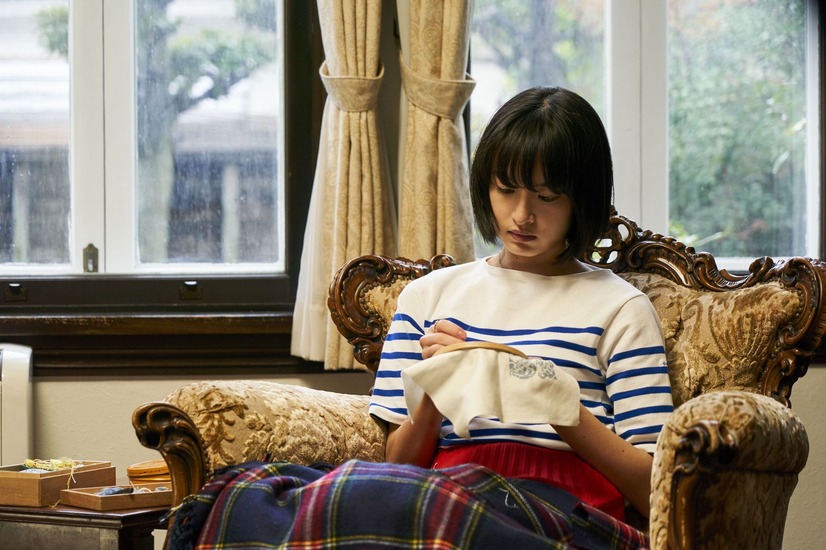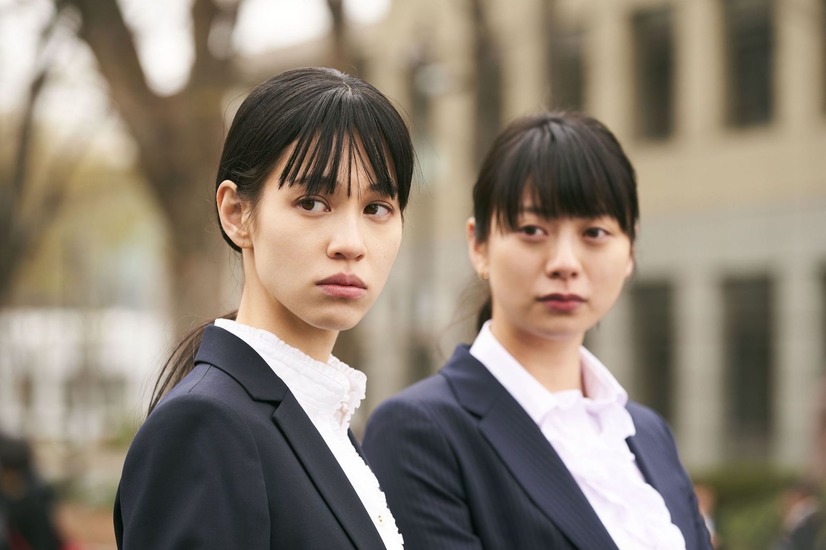Introduction
Ever since her first feature-length film Mime-Mime (2008) impressed audiences at international film festival, Yukiko Sode has been considered as one of the most-hoped-for young writer-directors. Her latest film, based on the novel ‘Anoko ha kizoku’ by Mariko Yamauchi, explores the fates of two women of different classes in contemporary Tokyo.
Review
2016. New Year’s Eve. The Haibara family, a family of doctors, has a fancy dinner at an equally fancy and expensive hotel. Hanako (Mugi Kadowaki), one of the daughters of the family, is running late. Eventually she arrives. Just seated at the dinner table, her mother (-) asks where her fiancée is. Hanako tells her and the family that they just broke up. Her grandmother, knowing that a former student from Dr Fujisawa, Mr. Watanabe (-) has just returned from his study in America, proposes a marriage meeting between the two. Hanako accepts, but the meeting is a let-down.
To get married before she becomes thirty, she starts, following the advice of others, meeting other men. One night, at a meeting arranged by her sister’s husband, she meets Koichiro Aoki (Kengo Kora), a legal advisor. They hit it off and begin dating regularly. Not that much later, he proposes to her. The same night Hanako discovers that he is messaging a woman called Miki Tokioka (Kiko Mizuhara).
While we could call Aristocrats a dramatic romantic narrative, the narrative is surprisingly devoid of romance, passion, conflict, and drama. This lack of emotionality might disappoint spectators but is truly important in the message that Yukiko Sode wants to express with her narrative. If the narrative can be called a drama, it is precisely because the narrative lacks drama.
Aristocrats, in short,explores the trajectory of two women who start engaging with a man who, on the one hand, attempts to pursue his own subjective desire while, on the other hand, satisfying the restrictive patriarchal desire and demands of his wealthy family. Koichiro, himself victim of his family name and upbringing, does not want to surrender his subjective desire nor give up the privileges he has by remaining inscribed in the strict patriarchal familial Other. His double position evokes the truth that that male elite subjects often organize their life around two objects, a marital object as accessory, to support one’s social face, to please the face of the family, and to ensure the continuation of the family and a forbidden trophy-like object to desire and/or to enjoy.
As the narrative unfolds another truth is subtle touched upon; The very fact that, due to the importance of maintaining the social image of oneself and the family, a woman often feels like she needs to accept her husband’s behaviour and remain faithful to someone who, besides playing his part in the theatre of patriarchal traditionality, seeks, behind the curtain, to please his own subjective desire. If the narrative delivers a statement, it is against this, against the fact that women, within such high-class patriarchal systems, are victims who do not only feel forced to support the marital façade but are also led to think that they are unable to escape the romantic injustice they are subjected to.
The drama of the narrative lies in the fact that nothing changes – that the patriarchal logic of the elite keeps functioning in its damaging way. Either women support their own subtle exploitation because they value their own social face and have too much to lose or they do escape, through divorce, but are considered damaged goods and a shame to the family. Yet – and this is nicely underlined by Yukiko Sode – subjective happiness is not to be found in accepting one’s own exploitation.
While we already made the message of Sode’s narrative explicit, we also want to highlight two elements, elements that differentiates between the classes, that Sode evokes in her Aristocrats. The first element concerns the presence of a subtle superior feeling. One easily feels, following the myriad of interactions between the members of the rich Haibara family at their new-year’s eve dinner, the distance that they install between them and the inferior and even barbaric plebeians. Their interactions are not only marked by a certain ignorance of the plebeian world, but also by an explicit disdain for this world as such. Even Hanako is subtly marked by this kind of thinking. Her assumption that she will be introduced to a guy by her manicurist at a fancy Italian restaurant instead of an Izakaya proves nothing other.
Another differentiating element that Aristocrats touches upon is the fact that, within rich families, the status of the family presides over subjective desire. While in the discussion about Hanako’s future marriage, Hanako’s desire is considered, the spectator feels that final decision about whom she will marry lies not in her hands – It has to be someone good for the family. How Koichiro’s grandfather, the diet member, gives their marriage his blessing betrays the very same ‘truth’.
Yet, the danger we face by focusing too much on class-differences is that we fail to discern that another and more important tension structures the narrative: the tension between modernity and tradition that marks all different classes. In the case of the Haibara family, this tension is made palpable in the very conflict between those who adhere to the traditional ways of matching couples and the rebellious divorced daughter who emphasizes a more subject-driven approach to ensnare a man. This tension is also discernable in Hanako’s search for a husband. She does not only attempt the formal and traditional kind of Omiai, but also less formal and more ‘modern’ ways of finding her match – e.g. a dating-app (General-note 1).
Yet, by exploring this tension, it becomes evident that it is especially the lifestyle of the higher classes that remains dictated by such patriarchal traditionality. Beyond the financial difference, what differentiates the classes from each other is nothing other than the difference in the level by which social interactions are ritualized and coldly formalized (Narra-note 1, Narra-note 2).
The composition of Aristocrats is straightforward, offering a balanced mix between static moments and dynamic moments. While Sode’s composition features some beautiful shots, masterfully exploiting geometry for visual delight, her composition is, for the most part, framed with purely instrumental visuals.
What stands out in the composition of Aristocrats is the structure of the narrative as such. Sode’s narrative structure does not only avoid showing direct conflict or passion but develops the subjective trajectory of its protagonists in a very allusive way. This is, in other words, not a narrative that spells things out, but a narrative that gains depth by its allusive nature. While this kind of structure might put off certain spectators, the very structure of the narrative echoes the difficulty of direct communication in the world of patriarchally structured elite.
Mugi Kadowaki’s performance is great. With much nuance and subtlety, she succeeds in making the sudden surge of romantic feelings Hanako experiences and the relational awkwardness these feelings cause truly believable (Narra-note 3). It is, as a matter of fact, her performance that drives the narrative and allows the narrative to become such an engaging experience.
Aristocrats is a great narrative, not only because Yukiko Sode beautifully evokes how women become victim of the traditional patriarchal elite and how subjective happiness is not found in the mere acceptance of one’s own exploitation, but also because she succeeds in revealing something (highly problematic) about this class via the way she structured her narrative as such. Yet, this a-dramatic structure might also put off and disappoint spectators. Yet, it seems that Sode intended to generate some disappointment in the spectator. A risky choice, because it will divide her audience, but also brilliant because it shows that she is not afraid to play with her spectators to make her point.
Notes
General-note 1: We should note that the practice of Omiai takes on different forms – a traditional and a contemporary form – in contemporary Japanese society. Besides the formally structured kind of Omiai, like the one Hanako attends, there are also less formal Omiai, Omiai parties organized by friends in Izakaya.
Narra-note 1: Hanako belongs to a higher class, but Koichiro Aoki belongs to an even higher class, the class of the elites, a class of lawyers, company presidents, and politicians. Miki Tokioka, for that matter, belongs to the middle class – a middle class family, due to circumstances, finds itself on the verge of poverty.
Narra-note 2: Miki, for that matter, suddenly finds herself, at Keio university, intermingling with the elites, meeting a gaudy and expensive lifestyle that is at odds with her humbler upbringing. While, at first, she is flustered by the contrast between what she, in her daily life, considers normal and the standards of the elite, she soon becomes adjusted to it, entertained by a desire to assume her own place within the higher echelons of society.
One day, her mother warns her that, due to financial circumstances, they won’t be able to pay for her studies, Miki decides to quit her studies and start working as a hostess – the better one is in ensnaring male customers with phallic masturbatory talk, the more money one is able to extract from those self-satisfied men. Eventually – thanks to one of her costumers – she also begins working at a company.
Narra-note 3: This sudden surge of romantic feelings is, as a matter of fact, the only moment of genuine emotionality in Aristocrats.







One Comment Add yours